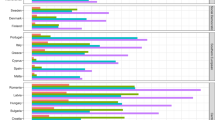Abstract
Population estimates are widely used in fund allocation, revenue sharing, planning, and budgeting at the federal, state, and local levels; as such, accuracy is crucial, and finding the most appropriate data and method to produce the accurate results is a constant goal for estimates professionals.
This chapter examines the viability of the housing unit method, typically used at the sub-county level, for county level estimates. Would this straightforward and easy-to-implement method generate more accurate estimates than the ratio-correlation method or administrative record method? The findings, while not surprising, provide empirical evidence through a thorough, careful, and clear case study.
Access this chapter
Tax calculation will be finalised at checkout
Purchases are for personal use only
Similar content being viewed by others
Notes
- 1.
Housing unit estimates are typically produced for July 1 and were linearly interpolated between July 1, 2009, and July 1, 2010, to obtain an estimate for April 1, 2010.
References
Cai, Q., & Spar, M. (2008). An evaluation of housing unit-based estimates in Virginia. Charlottesville: Weldon Cooper Center.
Hoque, N. (2012). Evaluation of small area population estimates produced by housing unit, ratio-correlation, and component method II compared to 2000 census counts. Canadian Studies in Population, 39(1–2), 91–108.
Smith, S. K. (1986). A review and evaluation of the housing unit method of population estimation. Journal of the American Statistical Association, 81, 287–296.
Smith, S. K., & Cody, S. (2013). Making the housing unit method work: An evaluation of 2010 population estimates in Florida. Population Research and Policy Review, 32(2), 221–242.
Smith, S. K., & Lewis, B. (1980). Some new techniques for applying the housing unit method of local population estimation. Demography, 17, 323–339.
Smith, S. K., & Mandell, M. (1984). A comparison of population estimation methods: Housing unit versus component II, ratio correlation, and administrative records. Journal of the American Statistical Association, 79(386), 282–289.
Starsinic, D. E., & Zitter, M. (1968). Accuracy of the housing unit method in preparing population estimates for cities. Demography, 5, 475–484.
Swanson, D. A., & Hough, G. C. Jr. (2012). An evaluation of persons per household (PPH) estimates generated by the American Community Survey: A demographic perspective. Population Research and Policy Review, 31(2), 235–266.
Author information
Authors and Affiliations
Corresponding author
Editor information
Editors and Affiliations
Rights and permissions
Copyright information
© 2015 Springer Science+Business Media Dordrecht
About this chapter
Cite this chapter
Cai, Q., Tippett, R. (2015). Housing-Unit Method in Comparison: The Virginia Case. In: Hoque, M., B. Potter, L. (eds) Emerging Techniques in Applied Demography. Applied Demography Series, vol 4. Springer, Dordrecht. https://doi.org/10.1007/978-94-017-8990-5_7
Download citation
DOI: https://doi.org/10.1007/978-94-017-8990-5_7
Published:
Publisher Name: Springer, Dordrecht
Print ISBN: 978-94-017-8989-9
Online ISBN: 978-94-017-8990-5
eBook Packages: Humanities, Social Sciences and LawSocial Sciences (R0)




